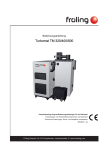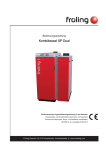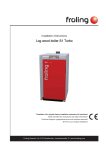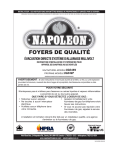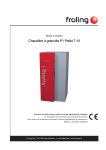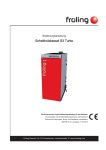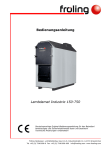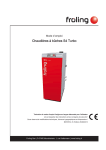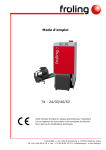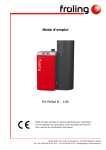Download Sharp TM150 Operating instructions
Transcript
Operating Instructions Turbomat TM 150/199/220 Translation of the original German operating instructions for the operator Read and follow the instructions and safety information! Technical changes, typographical errors and omissions reserved! B0310611_en Froling GesmbH | A-4710 Grieskirchen, Industriestraße 12 | www.froeling.com Contents Contents 1 General 4 1.1 Product overview 5 2 Safety 7 2.1 Hazard levels of warnings 7 2.2 Pictograms used 8 2.3 General safety information 9 2.4 Permitted uses 2.4.1 10 Wood pellets Wood shavings Miscanthus Changing the fuel 10 10 10 11 2.4.2 2.4.3 2.4.4 Non-permitted fuels Qualification of operating staff Protective equipment for operating staff 11 11 12 2.5 Design information 12 2.5.4 Installation and approval for the heating system General information for installation room (boiler room) Requirements for central heating water Return lift Use with storage tank 2.6 Safety devices 15 2.7 Residual risks 18 2.8 Emergency procedure 19 3 Operating the system 20 3.1 Assembly and initial startup 20 3.2 Filling/refilling the store with fuel 21 3.3 Heating the boiler 24 2.5.1 2.5.2 2.5.3 2.6.1 2.8.1 2.8.2 3.2.1 3.2.2 3.2.3 3.2.4 3.2.5 3.3.1 3.3.2 2 10 Permitted fuels External safety devices 12 12 13 14 14 17 Overheating of the system Smell of flue gas 19 19 Sliding floor discharge unit Horizontal screw feed system Inclined screw feed system Articulated arm / spring blade feed system Pellet discharge screw Switching on the system Switching on the boiler Heating up with automatic ignition (LM 500 Kom only) Heating up without automatic ignition 22 22 22 22 23 24 24 24 24 3.3.3 3.3.4 3.3.5 3.3.6 Kessel-Solltemperatur einstellen Controlling the boiler Switching off the boiler Switching off the system 25 25 25 26 4 Servicing 27 Froling GesmbH | A-4710 Grieskirchen, Industriestraße 12 | www.froeling.com Contents 4.1 General information on servicing 27 4.2 Inspection and cleaning 28 4.3 Maintenance schedule 29 Daily Weekly Monthly Quarterly Six-monthly Yearly Empty the ash container 30 30 31 32 34 36 39 4.3.1 Required jobs and checks 30 4.3.2 4.3.3 Maintenance schedule for safety devices Maintenance instructions for hydraulic system 40 41 4.4 Preparing to test emissions 42 4.5 Maintenance agreement / Customer service 42 4.6 Replacement parts 42 4.7 Disposal information 43 5 Troubleshooting 44 5.1 General faults in the power supply 44 5.2 Excessive temperature 44 5.3 Faults with fault message 45 6 Appendix 46 6.1 Addresses 46 4.7.1 4.7.2 5.1.1 5.3.1 6.1.1 6.1.2 Disposal of the ash Disposal of system components Behaviour of system after a power failure Procedure for fault messages Address of manufacturer Address of the installer Operating Instructions TM 150/199/220 | B0310611_en 43 43 44 45 46 46 3 1 General 1 General Thank you for choosing a quality product from Froling. The product features a state-ofthe-art design and conforms to all currently applicable standards and testing guide‐ lines. Please read and observe the documentation provided and always keep it close to the system for reference. It contains important safety information and all the operation and maintenance specifications needed to operate the system safely, properly and cost-ef‐ fectively. The constant further development of our products means that there may be minor dif‐ ferences from the pictures and content. If you discover any errors, please let us know. Subject to technical change. Guarantee conditions Our sale and delivery conditions generally apply. These conditions have been made available to customers, and customers have been made aware of them at the time of order completion. You can also find the guarantee conditions on the enclosed guarantee certificate. 4 Froling GesmbH | A-4710 Grieskirchen, Industriestraße 12 | www.froeling.com 1 General Product overview 1.1 Product overview 1 2 4 3 6 7 5 9 8 1 Wood chip boiler – Froling Turbomat 150 kW or 220 kW 2 Vertical 3-pass heat exchanger with Efficiency Optimisation System (WOS) 3 Cleaning port door 4 Multi-layer heat insulation for extremely low radiant heat losses. 5 Combustion chamber door 6 4-shelled high-temperature combustion chamber 7 Moving conveyor grate 8 Automatic ash removal to ash container 9 Trapezoidal stoker duct Operating Instructions TM 150/199/220 | B0310611_en 5 1 General Product overview 12 13 14 14 10 20 18 16 19 12 22 17 21 11 10 Switch cabinet with integrated Lambdatronic H 3000 controller 11 Main switch: Switches the power supply on and off for the entire system 12 Selector switch for induced draught fan: AUTO: The induced draught fan is switched on and off by the Lambdatronic H 3000 OFF: The induced draught fan is switched off MANUAL: The induced draught fan is switched on and is not controlled by the Lamb‐ datronic 6 13 Control panel of the Lambdatronic H 3000 controller 14 Status LED (operating status): - slow green flashing light: boiler active - fast green flashing light: boiler deactivated - red flashing light: fault 15 Two-line display showing operating mode, operating status, parameters, etc. 16 Start button: Switches the boiler on 17 Stop button: Switches the boiler off 18 Temperature selector: Sets the boiler temperature setpoint (setting range: 70 – 90°C) 19 Back button: Returns you from submenus, undoes inputs 20 Up arrow button: Moves up through the menu, increases or activates parameters 21 Down arrow button: Moves down through the menu, decreases or deactivates param‐ eters 22 Enter button: Takes you to submenus, calls or confirms inputs Froling GesmbH | A-4710 Grieskirchen, Industriestraße 12 | www.froeling.com 2 Safety Hazard levels of warnings 2 Safety 2.1 Hazard levels of warnings This documentation uses warnings with the following hazard levels to indicate direct hazards and important safety instructions: DANGER The dangerous situation is imminent and if measures are not observed it will lead to serious injury or death. You must follow the instructions! WARNING The dangerous situation may occur and if measures are not observed it will lead to serious injury or death. Work with extreme care. CAUTION The dangerous situation may occur and if measures are not observed it will lead to minor injuries or damage to property. Operating Instructions TM 150/199/220 | B0310611_en 7 2 Safety Pictograms used 2.2 Pictograms used The following symbols are used in the documentation and/or on the boiler to show what is required and forbidden and to give warnings. In accordance with machine guidelines, signs fitted directly in the hazard area indicate immediate hazards or safety procedures. These stickers must not be removed or cov‐ ered. Refer to the operating instruc‐ tions Wear safety shoes Wear protective gloves Wear hearing protection Keep the doors closed Turn off the main switch Unauthorised access prohibited 8 Hot surface warning Hazardous electrical voltage warning Hazardous or irritant materials warning Automatic boiler startup warning Hand injury warning Warning of injury to fingers or hands, automatic fan Cutting injury warning Warning of injury to fingers or hands, automatic screw Froling GesmbH | A-4710 Grieskirchen, Industriestraße 12 | www.froeling.com 2 Safety General safety information 2.3 General safety information DANGER If the device is used incorrectly: Incorrect use of the system can cause severe injury and damage. When operating the system: ❒ Observe the instructions and information in the manuals ❒ Observe the details on procedures for operation, maintenance and cleaning, as well as troubleshooting in the individual manuals. ❒ Any work above and beyond this should be carried out by authorised heating engineers or by Froling customer services. WARNING External influences: Negative external influences, such as insufficient combustion air or non-standard fuel can cause serious faults in combustion (e.g. spontaneous combustion of car‐ bonisation gases or flash fires) which can in turn cause serious accidents! When operating the boiler, please note the following: ❒ Instructions and information regarding versions and minimum values, as well as standards and guidelines for heating components in the instructions must be observed. WARNING Severe injuries and damage can be caused by an inadequate flue gas system. Problems with the flue gas system, such as poor cleaning of the flue pipe or insuf‐ ficient chimney draught can cause serious faults in combustion (such as sponta‐ neous combustion of carbonisation gases or flash fires). Take the following precautions: ❒ Optimum boiler performance can only be guaranteed if the flue gas system is functioning correctly. Operating Instructions TM 150/199/220 | B0310611_en 9 2 Safety Permitted uses 2.4 Permitted uses The Froling Turbomat TM is designed exclusively for heating domestic water. Only use fuels specified in the "Permitted fuels" section. ⇨ See "Permitted fuels" [page 10] The boiler should only be operated when it is in full working order. It should be operat‐ ed in accordance with the instructions, observing safety precautions, and you should ensure you are aware of the potential hazards. The inspection and cleaning intervals in these operating instructions should be observed. Ensure that any malfunctions which might impact safety are traced and removed immediately. The manufacturer and supplier are not liable for any damage resulting from non-permitted uses. 2.4.1 Permitted fuels Wood pellets Holzpellets aus naturbelassenem Holz mit einem Durchmesser von 6mm Normenhinweis EU: EN 14961-2 - A1 Österreich: ÖNORM M 7135 - HP 1 und/oder Zertifizierungsprogramm DINplus Deutschland: DIN 51731 - HP 5, Zertifizierungsprogramm DINplus und/oder ÖNORM M 7135 - HP 1 Allgemein gilt: Lagerraum vor Neubefüllung auf Pelletsstaub prüfen und gegebenenfalls reinigen! Wood shavings Holzspäne gelten generell als problematisch bei der Verbrennung. Daher ist der Ein‐ satz dieses Brennstoffes nur nach Freigabe durch Fa. Fröling erlaubt. Darüber hinaus gelten zusätzliche Hinweise: ▪ Sägespäne und Tischlereiabfälle dürfen nur bei Anlagen mit Zellradschleuse ein‐ gesetzt werden! ▪ Der Lagerraum ist entsprechend den regionalen Vorschriften mit einer Drucken‐ tlastungseinrichtung zu versehen! ▪ Für den zulässigen Wassergehalt von Spänen gelten dieselben Grenzen wie bei Hackgut! NOTICE Bei Brennstoffen mit Wassergehalt < W30 wird die Nennwärmeleistung des Kes‐ sels nur in Verbindung mit einer Abgasrezirkulation (AGR) gewährleistet! Miscanthus Switchgrass or elephant grass (Latin name: miscanthus) is a C4 plant. Standards and regulations for burning these plants have not been standardised, so the following ap‐ plies: NOTICE! The regional regulations for burning miscanthus should be observed. Opera‐ tion may only be possible by special permit. 10 Froling GesmbH | A-4710 Grieskirchen, Industriestraße 12 | www.froeling.com 2 Safety Permitted uses Changing the fuel CAUTION Incorrect parameter settings: Incorrect parameter settings have a significant adverse effect on the functioning of the boiler, and as a result this will invalidate the guarantee. Take the following precautions: ❒ If the fuel is changed (e.g. from wood chips to pellets), the system must be reset by Froling customer services. 2.4.2 Non-permitted fuels Der Einsatz von Brennstoffen, die nicht im Abschnitt "Zulässige Brennstoffe" definiert sind, insbesondere das Verbrennen von Abfall, ist nicht zulässig CAUTION Bei Verwendung unzulässiger Brennstoffe: Das Verbrennen von unzulässigen Brennstoffen führt zu einem erhöhten Reini‐ gungsaufwand und durch die Bildung von aggressiven Ablagerungen und Schwitzwasser zur Beschädigung des Kessels und in weiterer Folge zum Verlust der Garantie! Darüber hinaus kann die Verwendung nicht normgerechter Brenn‐ stoffe zu schwerwiegenden Störungen der Verbrennung führen! Beim Betreiben des Kessels gilt daher: ❒ Nur zulässige Brennstoffe verwenden 2.4.3 Qualification of operating staff CAUTION If unauthorised persons enter the Boiler room: Risk of personal injury and damage to property ❒ The operator is responsible for keeping unauthorised persons, in particular children, away from the system. Only trained operators are permitted to operate the unit. The operator must also have read and understood the instructions in the documentation. Operating Instructions TM 150/199/220 | B0310611_en 11 2 Safety Permitted uses 2.4.4 Protective equipment for operating staff You must ensure that staff have the protective equipment specified by accident pre‐ vention regulations. ▪ For inspection and cleaning: - suitable workwear - protective gloves - sturdy shoes ▪ Additional for operating: - Hearing protection (sound level > 70 dB) - Protective goggles 2.5 Design information Carrying out modifications to the system and changing or deactivating safety equip‐ ment is prohibited. Always comply with all fire, building, and electrical regulations when installing or oper‐ ating the system, in addition to following the operating instructions and mandatory reg‐ ulations that apply in the country in which the tank is operated. 2.5.1 Installation and approval for the heating system The boiler should be operated in a closed heating system. The following standards govern the installation: Note on standards ÖNORM / DIN EN 12828 Heating Systems in Buildings NOTICE! Each heating system must be officially approved. The appropriate supervisory authority (inspection agency) must always be informed when installing or modifying a heating system, and authorisation must be obtained from the building authorities: Austria: Inform the civic/municipal building authorities. Germany: Notify an approved chimney sweep and the building authorities. 2.5.2 General information for installation room (boiler room) Boiler room characteristics ▪ There must not be a potentially explosive atmosphere in the boiler room as the boiler is not suitable for use in potentially explosive environments. ▪ The boiler room must be frost-free. ▪ The boiler does not provide any light, so the customer must provide sufficient light‐ ing in the boiler room in accordance with national workplace design regulations. ▪ When using the boiler above 2000 metres above sea level you should consult the manufacturer. 12 Froling GesmbH | A-4710 Grieskirchen, Industriestraße 12 | www.froeling.com 2 Safety Design information ▪ Danger of fire due to flammable materials. No flammable materials should be stored near the boiler. Flammable objects (e.g. clothing) must not be put on the boiler to dry. ▪ Damage due to impurities in combustion air. Do not use any solvents or cleaning agents containing chlorine in the room where the boiler is installed. ▪ Keep the air suction opening of the boiler free of dust. Ventilation of the boiler room Ventilation air for the boiler room should be taken from and expelled directly outside, and the openings and air ducts should be designed to prevent weather conditions (foli‐ age, snowdrifts, ...) from obstructing the air flow. Unless otherwise specified in the applicable building regulations for the boiler room, the following standards apply for the design and dimensions of the air ducts: Note on standards ÖNORM H 5170 - Construction and fire protection requirements TRVB H118 - Technical directives on fire protection/prevention 2.5.3 Requirements for central heating water The following standards and guidelines apply: Note on standards Austria: ÖNORM H 5195-1 Germany: VDI 2035 Switzerland: SWKI 97-1 Italy: D.P.R. no. 412 NOTICE! Note on filling with make-up water: Always bleed the filling hose before con‐ necting, in order to prevent air from entering the system. Operating Instructions TM 150/199/220 | B0310611_en 13 2 Safety Design information Return lift If the hot water return is below the minimum return temperature, some of the hot water outfeed will be mixed in. CAUTION Risk of dropping below dew point/condensation formation if operated without re‐ turn lift. Condensation water forms an aggressive condensate when combined with com‐ bustion residue, leading to damage to the boiler. Take the following precautions: ❒ Regulations stipulate the use of a return lift. ➥ The minimum return temperature is 65 °C. We recommend fitting some kind of control device (e.g. thermometer). 2.5.4 Use with storage tank NOTICE In principle it is not necessary to use a storage tank for the system to run smooth‐ ly. However we recommend that you use the system with a storage tank, as this ensures a continuous supply of fuel in the ideal output range of the boiler. For the correct dimensions of the storage tank and the line insulation (in accordance with ÖNORM M 7510 or guideline UZ37) please consult your installer or Froling. ⇨ See "Addresses" [page 46] 14 Froling GesmbH | A-4710 Grieskirchen, Industriestraße 12 | www.froeling.com 2 Safety Safety devices 2.6 Safety devices 1 A 2 C 3 B 3 4 6 5 Operating Instructions TM 150/199/220 | B0310611_en 15 2 Safety Safety devices Item 1 Description Main switch Description Before starting any maintenance work: Switch off the entire system ❒ The power to all components is switched off. 2 Stop button If the system overheats: Switch off the boiler ❒ The pumps continue to run ➥ CAUTION! Always turn off the heating using the STOP button. Never use the main switch. 3 Door switch Switches the induced draught fan to full speed if the door is opened while the boiler is running 4 Safety overload switches, motor overload switch Switch off the related component in the event of fault currents or overloads 5 Power supply fuses Properly fuse the control system and any electronic components F1 Primary transformer 800 mAT F2 Power supply 5 VDC 1.6 AT F3 Power supply +15 VDC 200 mAT F4 Power supply -15 VDC 200 mAT F5 Power supply 24 VDC 2.0 AT F6 Power supply 12 VDC 3.15 AT ❒ When changing fuses, fit fuses with the rated current specified. 6 Motherboard fuse Motherboard fuse 5 AT ❒ When changing the fuse, fit a fuse with the rated current specified. 5 Devices for preventing the boiler from overheating A Boiler controller Switches the boiler and feed off if the boiler temperature reaches a prede‐ fined value (default 5°C) above the boiler temperature setpoint. B Thermal discharge safety device At a temperature of around 100°C a valve opens and sends cold water to the safety heat-exchanger (safety battery) to reduce the temperature. C Safety temperature limiter (STL) Switches off the blower fan at a maximum boiler temperature of 105°C. The pumps continue to run. Once the temperature falls to below approx. 75°C, the STL can be reset mechanically: ❒ Unscrew the cap on the safety temperature limiter ❒ Reset the safety temperature limiter by pressing with a screwdriver D 16 Safety valve When the boiler pressure is too high, the safety valve opens and vents off (not illustrated, provided by the custom‐ the hot water as steam. er) ❒ Before you start up the system again, top up the system to replace any water which has been lost through venting. Froling GesmbH | A-4710 Grieskirchen, Industriestraße 12 | www.froeling.com 2 Safety Safety devices 2.6.1 External safety devices Safety cut-out switch for sliding floor hydraulic chamber Before starting any maintenance work in the hydraulic chamber of the sliding floor: ❒ Turn the safety cut-out switch to the "0" position ➥ The boiler follows the shutdown procedure and the discharge system is deacti‐ vated ❒ Turning the selector switch past the "0" position engages the locking lever ➥ The switch can be locked with a padlock to prevent it from being switched on again On completion of the maintenance work: ❒ Remove the padlock ❒ Turn the selector switch past the "0" position to automatically release the locking switch. The selector switch can now be turned back to the "1" position. ❒ Acknowledge the fault and press the Start button to activate the boiler Operating Instructions TM 150/199/220 | B0310611_en 17 2 Safety Residual risks 2.7 Residual risks WARNING When touching hot surfaces: Severe burns are possible on hot surfaces and the flue gas pipe! When work is carried out on the boiler: ❒ Shut down the boiler in a controlled way (operating status "Switched off Off") and allow it to cool down ❒ Protective gloves must generally be worn for work on the boiler, and it should only be operated using the handles provided ❒ Insulate the flue pipes or simply avoid touching them during operation. WARNING If the combustion chamber, cleaning port, reversing chamber or middle vault door is opened during operation: Opening a door may result in injury or damage or flue gas generation! Take the following precautions: ❒ Do not open the doors while the boiler is operating! WARNING If non-permitted fuel types are used: Non-standard fuels can cause serious faults in combustion (e.g. spontaneous combustion of carbonisation gases / flash fires) which can lead to serious acci‐ dents! Take the following precautions: ❒ Only use fuels specified in the "Permitted fuels" section of these operating in‐ structions. 18 Froling GesmbH | A-4710 Grieskirchen, Industriestraße 12 | www.froeling.com 2 Safety Emergency procedure 2.8 Emergency procedure 2.8.1 Overheating of the system If the system overheats and the safety devices fail to operate, proceed as follows: NOTICE! Do not under any circumstances switch off the main switch or disconnect the power supply. ❒ Keep all the doors on the boiler closed ❒ Open all mixer taps, switch on all pumps. ➥ The Froling heating circuit control takes on this function in automatic operation. ❒ If a third-party controller is used, carry out the appropriate measures to activate the mixer taps and pumps manually. ❒ Leave the boiler room and close the door ❒ Increase heat consumption by turning on all radiators and other appliances ❒ Open any available radiator thermostat valves If the temperature does not drop: ❒ Contact the installer or Froling customer services ⇨ See "Addresses" [page 46] 2.8.2 Smell of flue gas DANGER If you smell flue gas in the boiler room: Inhaling toxic flue gas can potentially be fatal! If you smell flue gas in the room where the boiler is installed: ❒ Keep all the doors on the boiler closed ❒ Shut down the boiler according to procedure ❒ Ventilate the room where the boiler is installed ❒ Close the fire door and doors to living areas Operating Instructions TM 150/199/220 | B0310611_en 19 3 Operating the system Assembly and initial startup 3 Operating the system 3.1 Assembly and initial startup Montage, Installation und Erstinbetriebnahme des Kessels darf nur durch qualifiziertes Personal erfolgen und wird in der beigelegten Montageanleitung beschrieben. Siehe Montageanleitung Turbomat TM NOTICE Optimum efficiency and efficient, low-emission operation can only be guaranteed if the system is set up by trained professionals and the standard factory settings are observed. Take the following precautions: ❒ Initial startup should be carried out with an authorised installer or with Froling customer services Vor Inbetriebnahme durch den Fröling-Werkskundendienst müssen bauseitig folgen‐ den Vorarbeiten abgeschlossen sein: ▪ Elektrische Installation ▪ Wasserseitige Installation ▪ Abgas-Anschluss inkl. aller Isolierarbeiten ▪ Arbeiten zur Einhaltung der örtlichen Brandschutzbestimmungen ▪ Seitens des Betreibers muss gewährleistet sein, dass zur Inbetriebnahme vom Netz mind. 50% der Nennwärmeleistung des Kessels abgenommen werden kön‐ nen. ▪ Durch den notwendigen „Trockenlauf“ der Anlage muss das Austragsystem zu Be‐ ginn der Inbetriebnahme leer sein. Das Brennmaterial sollte jedoch verfügbar sein, da nach der Freigabe das Austragsystem befüllt wird. ▪ Für den ersten Aufheizvorgang zur Trocknung des Schamott-Betons ist bauseitig ca. 1m³ trockenes Scheitholz zur Verfügung zu stellen. ▪ Der ausführende Elektriker sollte zum Inbetriebnahmetermin für eventuelle Änder‐ ungen an der Verkabelung verfügbar sein. ▪ Im Zuge der Inbetriebnahme wird eine einmalige Einschulung des Betreibers/Be‐ dienpersonals durchgeführt. Die Anwesenheit der betreffenden Person(en) ist für die ordnungsgemäße Übergabe des Produktes erforderlich! 20 Froling GesmbH | A-4710 Grieskirchen, Industriestraße 12 | www.froeling.com 3 Operating the system Filling/refilling the store with fuel 3.2 Filling/refilling the store with fuel Generell ist beim Befüllen des Lagerraumes auf die Verwendung des richtigen Brenn‐ stoffes zu achten: ⇨ See "Permitted fuels" [page 10] Für das Einblasen von Brennmaterial gilt zusätzlich: Anlagen, bei denen das Brennmaterial mittels Tankwagen angeliefert und in den La‐ gerraum eingeblasen wird, müssen mit einer Zellradschleuse ausgestattet sein. Der Kessel muss beim Befüllen des Lagerraumes im Zustand „Ausgeschaltet AUS“ bzw. „Ausgeschaltet Mantelkühlung“ sein. Der beim Einblasen des Brennmaterials erzeugte Unterdruck könnte zum Rückrauchen führen. CAUTION Risk of injury and damage to property from blowing fuel into the store with the boiler switched on! Take the following precautions: ❒ Switch off the boiler by pressing the Stop button ❒ Set the boiler to "Switched off Off" or "Switched off Case cooling on" and leave to cool for at least two hours. Bevor eine Befüllung des Lagerraumes erfolgt, ist immer darauf zu achten, dass sich keine Fremdkörper im Lagerraum befinden. Alle Öffnungen des Lagerraumes staubdicht verschließen! Operating Instructions TM 150/199/220 | B0310611_en 21 3 Operating the system Filling/refilling the store with fuel 3.2.1 Sliding floor discharge unit ❒ The maximum dumping height (depending on the fuel density) as specified in the operating instructions for the sliding floor must not be exceeded. ❒ Driving over the fuel in the store can cause the material to be compacted. ➥ This may stop the slide rods from running smoothly. Filling the store by driving over the slide rods Slide rods can be driven over, provided the following precautions are taken: ❒ The slide rods must be covered by a residual fuel layer approx. 30 cm deep so that the truck does not drive directly over the sliding floor keyways. ❒ On no account may the truck drive over the longitudinal support for the slide rods. (Provide guidance systems for driving the truck into the store, or position gates ap‐ propriately) ❒ While the truck is on the sliding floor, the hydraulic unit must be switched off ❒ While it is on the sliding floor the truck should be manoeuvred as little as possible Filling the store by tipping fuel onto or next to the slide rods ❒ If the fuel can be tipped out without driving over the slide rods, the store can be filled while the boiler is running 3.2.2 Horizontal screw feed system ❒ When the boiler system is running, fuel can be tipped into the store at any time. ➥ CAUTION: Fuel may only be blown in if the pressure conditions in the store are suitable and the water content of the fuel does not exceed a maximum of W30. 3.2.3 Inclined screw feed system The inclined screw must always be moved into an upright position in order to fill the store. This can be done as follows: ❒ If the store is filled while the boiler system is running, the screw moves automati‐ cally into an upright position. ➥ If the store is empty, the screw must be moved by hand into an upright position and wedged with fuel. ❒ If the feed system is not running when the store is filled, the screw can be held upright using string. ➥ TIP: The string should be thin enough for it to break as the store is filled. 3.2.4 Articulated arm / spring blade feed system Blowing in fuel with the stirrer head still covered ❒ If the head of the stirrer is still covered with fuel and the arms are drawn in against the stirrer plate, fuel can be blown in at any time provided the boiler is switched off 22 Froling GesmbH | A-4710 Grieskirchen, Industriestraße 12 | www.froeling.com Operating the system Filling/refilling the store with fuel 3 Blowing in fuel with the stirrer arms free and residual fuel present ❒ Before filling the store, shovel any residual fuel over the middle of the stirrer ❒ Switch on the stirrer for 4 minutes using the "Man. fuelling in com. chamb." parameter to draw the arms in. ❒ When the arms are drawn in against the stirrer plate, the store can be filled by blowing in fuel. ❒ Any fuel that was introduced into the combustion chamber when the stirrer was switched on must be removed manually. Blowing in fuel to an empty bunker If the store is empty, stop blowing in fuel after about 5 minutes and take a look in the store. If the middle of the stirrer is covered with fuel and the arms are no longer visible: ❒ Activate the stirrer for 4 minutes using the "Man. fuelling in com. chamb." parameter ❒ Once the arms are drawn in, filling can continue. ➥ If the layer of fuel on top of the stirrer is not deep enough after the first 5 mi‐ nutes to allow the spring blades or articulated arms to be drawn in, repeat the process until there is enough fuel present. ❒ Any fuel that was introduced into the combustion chamber when the stirrer was switched on must be removed manually. 3.2.5 Pellet discharge screw ❒ Provided all the conditions in 3.3 are met, filling can be started at any time. Operating Instructions TM 150/199/220 | B0310611_en 23 3 Operating the system Heating the boiler 3.3 Heating the boiler 3.3.1 Switching on the system ❒ Turn the main switch on the switch cabinet to the "ON" position ➥ After the system check by the controller, the system is ready for operation ➥ "Switched off Off" appears on the display 3.3.2 Switching on the boiler Heating up with automatic ignition (LM 500 Kom only) ❒ Press the Start button ➥ Fuel is fed into the combustion chamber and heated by the ignition blower fan. ➥ The heating system is controlled via the controller according to the selected mode. Heating up without automatic ignition Prepare the material: ❒ paper and cardboard ❒ coarse wood chips ❒ dry firewood With the boiler switched off: ❒ Set the "ID fan" selector switch to "OFF" ❒ The ID fan is deactivated and does not start up automatically when the combus‐ tion chamber door is opened ❒ Place some scrunched-up paper and cardboard inside ❒ Place some coarse wood chips on top and finally some firewood ❒ Light the paper ❒ Set the "ID fan" selector switch to "MANUAL" ➥ The ID fan starts up ➥ This helps to ignite the material more quickly and prevents smoke from devel‐ oping inside the boiler room ➥ Leave the combustion chamber door open! 24 Froling GesmbH | A-4710 Grieskirchen, Industriestraße 12 | www.froeling.com 3 Operating the system Heating the boiler Once the firewood is alight: ❒ Use the cleaning tool to push fuel to the back of the combustion chamber Start the boiler: ❒ Close the combustion chamber door ❒ Set the "ID fan" selector switch to "AUTO" ❒ Acknowledge the combustion chamber door error message ❒ Press the Start button ➥ The boiler is switched on and begins to heat up 3.3.3 Kessel-Solltemperatur einstellen Kessel-Solltemperatur erhöhen: ❒ Temperaturwähler nach rechts drehen ➥ Kessel-Solltemperatur wird erhöht Rechter Anschlag entspricht der eingestellten Kessel-Solltemperatur (max. 90°C) Kessel-Solltemperatur verringern: ❒ Temperaturwähler nach links drehen ➥ Kessel-Solltemperatur wird verringert Linker Anschlag entspricht 70°C 3.3.4 Controlling the boiler NOTICE! See the operating instructions for the Lambdatronic H 3000 3.3.5 Switching off the boiler ❒ Press the Stop button ➥ The boiler follows the shutdown program and switches to "Switched off Off" status ➥ The Lambdatronic controls the connected heating components. NOTICE! Always use the Stop button to shut down the boiler according to procedure. The pumps must continue to run for a minimum of 6 hours! Operating Instructions TM 150/199/220 | B0310611_en 25 3 Operating the system Heating the boiler 3.3.6 Switching off the system WARNING When switching off the main switch in automatic mode: Serious combustion faults leading to serious accidents are possible! Before switching off the main switch: ❒ Press Stop key ➥ The boiler follows the shutdown procedure and switches to the cleaning cycle in "Switched off Off "status CAUTION! Only when the boiler has cooled down and is in "Switched off Off" status ❒ Switch off the main switch on the controller ➥ The controller is switched off ➥ The components powered via the switch cabinet are powered down 26 Froling GesmbH | A-4710 Grieskirchen, Industriestraße 12 | www.froeling.com 4 Servicing General information on servicing 4 Servicing 4.1 General information on servicing Regular cleaning of the boiler extends its life and is a basic requirement for smooth operation. You should therefore clean the boiler regularly. DANGER When working on electrical components: Risk of electrocution! When work is carried out on electrical components: ❒ Only have work carried out by a qualified electrician ❒ Observe the applicable standards and regulations ➥ Work must not be carried out on electrical components by unauthorised people WARNING When inspecting and cleaning the boiler with the main switch on: Serious injuries possible due to automatic boiler startup! Before inspection and cleaning work in/on the boiler: ❒ Press the Stop button ➥ The boiler follows the shutdown procedure and switches to "Switched off Off" status ➥ Allow the boiler to cool down for at least 2 hours. ➥ Switch off the main switch and take precautions to prevent accidental switching on. WARNING Incorrect inspection and cleaning: Incorrect or insufficient inspection and cleaning of the boiler can cause serious faults in combustion (e.g. spontaneous combustion of carbonisation gases / flash fires) and this can lead to serious accidents and damage! Take the following precautions: ❒ Clean the boiler following the instructions in the instruction manual. Follow the boiler operating instructions. Operating Instructions TM 150/199/220 | B0310611_en 27 4 Servicing Inspection and cleaning WARNING Inspection and cleaning of the combustion chamber with the combustion chamber temperature sensor in position Risk of damage to the thermocouple! Before inspection and cleaning work in the combustion chamber: ❒ Mark the position of the thermocouple. ❒ Loosen the clamp and pull out the thermocouple. ➥ After maintenance: ❒ Carefully clean any tar or soot deposits from the thermocouple. ❒ Re-insert the thermocouple to the marked position and fix in place with the clamp. NOTICE We recommend that you keep a maintenance book in accordance with ÖNORM M7510 of the Technical Directive for Fire Prevention (TRVB) 4.2 Inspection and cleaning For inspection and cleaning use the cleaning kit provided. The cleaning kit consists of: ▪ Chamber plate (triangular plate) ▪ Flat scraper ▪ Large brush (Ø 81 mm) ▪ Small brush (Ø 53 mm) ❒ We recommend that you also use an industrial vacuum cleaner. 28 Froling GesmbH | A-4710 Grieskirchen, Industriestraße 12 | www.froeling.com Servicing Maintenance schedule 4 4.3 Maintenance schedule Operating Instructions TM 150/199/220 | B0310611_en 29 4 Servicing Maintenance schedule 4.3.1 Required jobs and checks ❒ The following maintenance schedule is based on max. 3000 service hours per year. ➥ Reduce the intervals if this number is exceeded. Daily 1 Chamber + heat exchanger ❒ General visual inspection ❒ Clean components if necessary ➥ Change defective components immediately. 2 ID fan + flue gas pipe ❒ General visual inspection ❒ Clean components if necessary ➥ Change defective components immediately. 3 Combustion air blower fan ❒ General visual inspection ❒ Clean components if necessary ➥ Change defective components immediately. Weekly 4 Geared motors ❒ Visually check all geared motors for oil leaks 5 Heat exchanger ash removal (not pictured) ❒ Check the ash level ❒ Check for unburned material and foreign bodies ❒ Empty ash container if necessary 6 Chamber ash removal ❒ Check the ash level ❒ Check for unburned material and foreign bodies ❒ Empty ash container if necessary 30 Froling GesmbH | A-4710 Grieskirchen, Industriestraße 12 | www.froeling.com 4 Servicing Maintenance schedule Monthly 7 Combustion chamber ❒ Using the flat scraper, pull the ash on the combustion chamber grate out through the cleaning port door ❒ Carefully remove deposits on side walls using the flat scraper and cleaning brush ➥ CAUTION! Be careful not to damage the firebricks with the flat scraper or cleaning brush. ❒ Shovel ash from the chamber into a fire-resistant container with a lid ❒ Check the burn-through rings Systems with automatic ash removal: ❒ After cleaning the boiler switch on the main switch on the switch cabinet ❒ Once the controller has initialised, switch on the ash removal screws in the "Test operation" menu to transfer the ash to the ash container ➥ The ash removal screws of the heat exchanger ash removal system will also operate at the same time. ❒ Empty ash container if necessary 8 Conveyor grate ❒ Check the conveyor grate for dirt and obstructions (nails, stones, slag,...). Clean where necessary ➥ The primary air slots (wood chip grate) or primary air holes (pellet grate) must be free and unobstructed ❒ Check the grate, grate shafts and grate bearings for wear and deformation Operating Instructions TM 150/199/220 | B0310611_en 31 4 Servicing Maintenance schedule ➥ Change any worn or deformed components ❒ Check the grate drive for dirt and deposits 9 Air-cooled grate side plates ❒ Check the grate side plates for dirt and slag and clean the openings with a slotted screwdriver if necessary Quarterly 10 Flue gas sensor ❒ Loosen the retaining screw and pull out the flue gas sensor ❒ Wipe off the flue gas sensor with a clean cloth ❒ Insert the flue gas sensor back into the flue gas pipe and finger-tighten the retain‐ ing screw 32 Froling GesmbH | A-4710 Grieskirchen, Industriestraße 12 | www.froeling.com 4 Servicing Maintenance schedule 11 Lambda probe ❒ Unscrew and remove the Lambda probe ➥ CAUTION: Lambda probe may be hot! ❒ Refit and finger-tighten the lambda probe ➥ Check the seal after tightening ➥ Do not use sharp objects or compressed air to clean the openings in the lamb‐ da probe 12 Conveyor grate In the chamber opposite the heat exchanger: ❒ Remove the cover from the cleaning hatch ❒ Remove the cleaning cover Operating Instructions TM 150/199/220 | B0310611_en 33 4 Servicing Maintenance schedule ❒ Check the grate area and ash rakes for dirt and deposits. Clean where necessary ➥ Check the seal when replacing the cleaning cover Six-monthly 13 Flue gas pipe (option) ❒ Remove the pipe insulation from the inspection cover ❒ Unfasten the nuts on the inspection cover and remove the cover ❒ Check the pipe for dirt and deposits. Clean where necessary 14 Actuators, drives ❒ Visually check the function of the drives of the feed and ash removal screws and the grate Check the efficiency of the air flap actuators: ❒ Press the reset button on the servo motor to release the air flap ➥ Hold down the reset button ❒ Turn the air flap to the left-hand stop ❒ Release the reset button ➥ The air flap must return automatically to its original position (only if the main switch is switched on) 34 Froling GesmbH | A-4710 Grieskirchen, Industriestraße 12 | www.froeling.com 4 Servicing Maintenance schedule 15 Heat exchanger ❒ Open the cover on the heat exchanger ❒ Remove all dirt and deposits from the chamber ❒ Check the turbulator or check the function of the WOS (min. stroke approx. 5 cm) ➥ Use a vacuum cleaner for this job. 16 Heat exchanger ash screw – ash removal ❒ Remove the ash container from the heat exchanger ash removal unit ❒ Remove the ash removal flange (some models have a 2-piece flange) ❒ Remove dirt and deposits from the sloping plates and from the ash screws. Operating Instructions TM 150/199/220 | B0310611_en 35 4 Servicing Maintenance schedule ❒ Check the seal when replacing the ash removal flange ➥ Because of the high temperatures to which the screw is exposed, never re‐ move all the ash. Always leave a thin layer of ash to protect it. Ignition (not pictured) ❒ The ignition pipe must be free ❒ Clean the photocell with a damp cloth (no detergent) Yearly 17 Underpressure controller ❒ Disconnect the silicone tube from the differential pressure transducer ❒ Using compressed air, blow out the line in the direction of the combustion cham‐ ber to remove any deposits ❒ Reconnect the silicone tube to the "minus" nipple 18 Combustion chamber overpressure sensor ❒ Loosen the retaining screw ❒ Pull the combustion chamber overpressure sensor out of the spacer tube ❒ Clean any deposits from the sensor with a soft cloth ❒ Check that the spacer tube is clear 36 Froling GesmbH | A-4710 Grieskirchen, Industriestraße 12 | www.froeling.com 4 Servicing Maintenance schedule 19 Heat exchanger cover ❒ Check fibre-glass seal for perfect alignment on the door frame ➥ Check the imprint on the fibre-glass seal. If the imprint of the seal is broken: ❒ The seal is no longer guaranteed ❒ Tighten the door latches or change the fibre-glass seal. 20 Cleaning port door + combustion chamber door ❒ Check fibre-glass seal for perfect alignment on the door frame ➥ Check the imprint on the fibre-glass seal. If the imprint of the seal is broken: ❒ The seal is no longer guaranteed ❒ Tighten the door latches or change the fibre-glass seal. ➥ If you adjust the combustion chamber door, check that the door switch is work‐ ing. Reset if necessary. 21 Combustion air blower fan ❒ Clean any dust and deposits from the protective grating ❒ Dismantle the protective grating and clean the fan with a soft brush where neces‐ sary 22 Induced draught fan + FGP blower Operating Instructions TM 150/199/220 | B0310611_en 37 4 Servicing Maintenance schedule ❒ Mark the position of the flange ❒ Loosen the blower flange screws ❒ Take out the blower and clean the blower wheel with a brush ➥ Refit in the marked position 22 Flue gas pipe ❒ Check the flue gas pipe and chimney for deposits and clean with the flue brush where necessary ➥ Always use stainless steel brushes to clean stainless steel flue pipes, chimney pipes and connections 23 Bearings ❒ Grease all bearings of the screws and the drives 24 Slide-in unit ❒ Check the function of the loading system sprinklers as per the manufacturer's in‐ structions 38 Froling GesmbH | A-4710 Grieskirchen, Industriestraße 12 | www.froeling.com 4 Servicing Maintenance schedule Empty the ash container Entaschung Wärmetauscher Entaschung Retorte Chamber ash removal: ❒ Unscrew the wing nuts on the ash container flange ❒ Separate the ash container from the flange and take the ash container to the ash disposal point Heat exchanger ash removal ❒ Unscrew the wing nuts on the ash box flange ❒ Separate the ash box from the flange and take the ash box to the ash disposal point Boiler with ash drawer (depending on model): ❒ Remove the star-shaped screws on the ash drawer flange ❒ Pull out the ash drawer and take it to the ash disposal point Operating Instructions TM 150/199/220 | B0310611_en 39 4 Servicing Maintenance schedule 4.3.2 Maintenance schedule for safety devices No. 1 Component / Maintenance Operation System pressure Int. D ❒ Check the system pressure on the pressure gauge ➥ The value must be 20% over the pre-stressed pressure of the ex‐ pansion tank NOTICE! See the expansion tank operating instructions If the system pressure is less: ❒ Top up the water ☞ If this occurs frequently it indicates that the heating system is not sealed correctly. Call the installer. ❒ If large pressure fluctuations are observed: ➥ Have the expansion tank checked. 2 Burn back flap W ❒ Check the seal and efficiency of the burn back flap 3 Safety valve (provided by the customer) M ❒ Check the safety valve as per the manufacturer's instructions NOTICE! See the safety valve operating instructions 4 Q Safety battery valve ❒ Pull the safety valve sensor out of its immersion sleeve ❒ Hold the sensor in a heated water tank fitted with a temperature dis‐ play ❒ Heat the water until the temperature reaches the setpoint value for the valve ➥ At this temperature the valve must open and allow cold water to flow into the safety battery ❒ After the test, push the valve sensor back into its immersion sleeve ❒ Check for water flowing out of the safety battery drain pipe ➥ Clean or change the valve if it leaks ☞ Risk of scaling in the safety heat exchanger ❒ If the heat exchanger is badly scaled, the flow rate will be very low. In this case the heat exchanger must be descaled by a specialist compa‐ ny. 5 Safety temperature limiter (STL) Y ❒ Pull the STL capillary sensor out of its immersion sleeve ❒ Hold the sensor in a heated water tank fitted with a temperature dis‐ play ❒ Heat the water until the temperature reaches the setpoint value (ap‐ prox. 100°C) for the STL ➥ The system will shut down and a fault message will be displayed ☞ If the system does not shut down, change the STL immediately ❒ Reset the STL by hand: ❒ Allow the sensor to cool down and then unscrew the cap from the STL ❒ Reset the safety temperature limiter by pressing with a screwdriver 6 Heating EMERGENCY STOP switch ❒ Check that the heating emergency stop switch is working properly 40 Froling GesmbH | A-4710 Grieskirchen, Industriestraße 12 | www.froeling.com 4 Servicing Maintenance schedule 4.3.3 Maintenance instructions for hydraulic system WARNING Do not use unskilled personnel for hydraulic system maintenance Risk of injury and damage to property! Take the following precautions: ❒ Only allow trained professionals to carry out servicing and maintenance work on the hydraulic system. Follow the manufacturer's operating instructions. NOTICE! Do not allow the oil temperature to exceed +50°C or fall below -30°C. The interval at which oil should be changed depends on a variety of factors including the age of the oil and the amount of dirt contained in it. As a general rule, the oil should be changed at the following intervals: Interval (service hours) 50 - 100 Component / Maintenance Operation First maintenance after installation. (This does not apply to subsequent mainte‐ nance): ❒ Change the oil and the filter 50 ❒ Check the oil level ➥ The oil must show no visible signs of foaming ❒ Check the tightness of screw connectors 200 ❒ Check the return filter for dirt (pressure gauge on filter) ❒ Change the filter cartridge if necessary 5000 (or yearly) ❒ Change the oil ❒ Change the return filter and the vent filter sets To change the oil, proceed as follows: ❒ Move all hydraulic cylinders to the end stop ➥ This will expel all the oil ❒ Drain off or pump off the oil from the hydraulic unit ❒ Remove the unit cover or open the inspection cover ❒ Thoroughly clean the oil tank (make sure you remove all oil sludge) ❒ Change the return filter and the vent filter sets ❒ Refit the unit cover or close the inspection cover ❒ Fill the tank with hydraulic oil to the level mark shown on the inspection glass ☞ Use the hydraulic oil grade specified by the manufacturer ❒ At the other end of the cylinder plunger (relative to its current position), disconnect the hydraulic cylinder hose on the fixed piping side. Place a container under the disconnected hose. ❒ Using the hydraulic unit move the cylinders to the other end position ➥ The remaining old oil will be pushed out of the hose and into the container. ❒ Refit the hydraulic hoses and check the seal ❒ Bleed the hydraulic system and check the oil level Operating Instructions TM 150/199/220 | B0310611_en 41 4 Servicing Preparing to test emissions 4.4 Preparing to test emissions ❒ According to the stipulations of Austrian standard ÖNORM M 5861-1, the flue gas piping must have a built-in DN100 test flange. ❒ The entire system must be thoroughly cleaned 2 to 3 days before emission tests are performed. (The entire system in this case means: ash containers, combustion chamber, vault, heat exchanger, smoke flue pipe connection between boiler and cyclone, container under cyclone, flue gas piping and chimney). ❒ System performance must be measured at full load and at partial load. ❒ In the last two days before the test, system output must be increased to approxi‐ mately the rated output of the boiler. This is to prevent the release during testing of any old deposits (e.g. tar) in the flue gas piping. ❒ Wood chip as per ÖNORM M 7133 with a maximum water content of 30% must be provided by the operator. Wood chip size: - for screw feed loading: max. G 50 - for hydraulic loading: max. G 100 ❒ One or two days before the test, the efficiency and settings of the system should be checked by our service technician.The system must be set up for the fuel to be used during the emission tests (test measurements by our service technician). ❒ Our service technician will be present at the tests. Emission tests should be car‐ ried out by an accredited test institute or, in Germany, a chimney sweep. 4.5 Maintenance agreement / Customer service NOTICE! We recommend a yearly inspection by Froling customer services or an au‐ thorised partner (third party maintenance). Regular maintenance and servicing by a heating specialist will ensure a long, troublefree service life for your heating system. It will ensure that your system stays environ‐ mentally-friendly and operates efficiently and cost-effectively. In the course of this maintenance the entire system is inspected and optimised, partic‐ ularly regulation and control of the boiler. The emission measurement carried out can also be used to draw conclusions about the combustion performance of the boiler. For this reason, FROLING offers a service agreement, which optimises operating safety. Please see the details in the accompanying guarantee certificate. Your Froling customer service office will also be happy to advise you. NOTICE All national and regional regulations relating to regular testing of the system must be observed. Please be advised that, in Austria, commercial systems with a rated heat output of 50 kW or more must be regularly tested at yearly intervals in ac‐ cordance with the Heating Plant Regulations (Feuerungsanlagen-Verordnung). 4.6 Replacement parts With Froling original replacement parts in your boiler, you are using parts that match perfectly. As the parts fit together so well, installation times are shortened and a long service life is maintained. 42 Froling GesmbH | A-4710 Grieskirchen, Industriestraße 12 | www.froeling.com 4 Servicing Disposal information NOTICE Installing non-original parts will invalidate the guarantee. ❒ Only replace components or parts with original replacement parts 4.7 Disposal information 4.7.1 Disposal of the ash ❒ The ash should be disposed of in accordance with waste management regula‐ tions. 4.7.2 Disposal of system components ❒ Ensure that they are disposed of in an environmentally friendly way in accordance with waste management regulations. ❒ You can separate and clean recyclable materials and send them to a recycling centre. ❒ The combustion chamber must be disposed of as builders' waste. Operating Instructions TM 150/199/220 | B0310611_en 43 5 Troubleshooting General faults in the power supply 5 Troubleshooting 5.1 General faults in the power supply Error characteristics Cause of error Elimination of error Nothing is shown on the dis‐ play General power failure No power to the controller Main switch is turned off Turn on the main switch FI circuit breaker or line pro‐ tection is switched off Switch on the FI circuit break‐ er or line protection Faulty fuse in the controller Replace the fuse – note the amperage (10AT) 5.1.1 Behaviour of system after a power failure When the power supply has been restored the boiler returns to the previous mode and is controlled according to the specified program. ❒ After a power failure, check whether the STL has tripped. ❒ Keep the doors of the boiler closed during and after the power failure. 5.2 Excessive temperature The safety temperature limiter (STL) shuts down the boiler when it reaches a tempera‐ ture of approx. 100°C. Once the temperature falls to below approx. 75°C, the STL can be reset mechanically: ❒ Unscrew the cap on the safety temperature limiter ❒ Reset the safety temperature limiter by pressing with a screwdriver ❒ Replace the cap 44 Froling GesmbH | A-4710 Grieskirchen, Industriestraße 12 | www.froeling.com 5 Troubleshooting Faults with fault message 5.3 Faults with fault message If a fault has occurred and has not yet been cleared: ❒ Status LED flashes red ❒ A fault message is shown on the display The term "fault" is a collective term for warnings, errors and alarms. The boiler reacts differently to the three types of message: WARNING In case of warnings the boiler initially continues controlled opera‐ tion, giving the option of resolving the error quickly to prevent a shutdown. ERROR The boiler follows the shutdown procedure and remains in "Switched off Off" status until the problem is resolved. ALARM An alarm triggers a system emergency stop. The boiler shuts down immediately, the heating circuit controller and pumps re‐ main active. 5.3.1 Procedure for fault messages ❒ Find and eliminate the fault NOTICE! For a list of messages refer to the Lambdatronic H 3000 operating instruc‐ tions ❒ Acknowledge fault by pressing the Enter button ❒ Start the boiler by pressing the Start button Operating Instructions TM 150/199/220 | B0310611_en 45 6 Appendix Addresses 6 Appendix 6.1 Addresses 6.1.1 Address of manufacturer FRÖLING Heizkessel- und Behälterbau GesmbH Industriestaße 12 A-4710 Grieskirchen AUSTRIA TEL 0043 (0)7248 606 0 FAX 0043 (0) 7248 606 600 INTERNET www.froeling com 6.1.2 Address of the installer Stamp 46 Froling GesmbH | A-4710 Grieskirchen, Industriestraße 12 | www.froeling.com














































